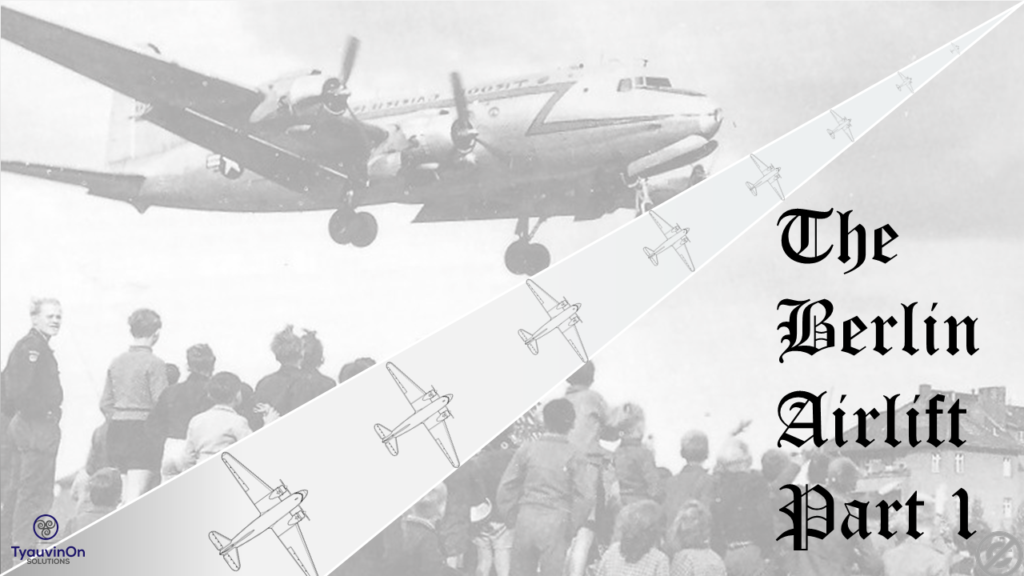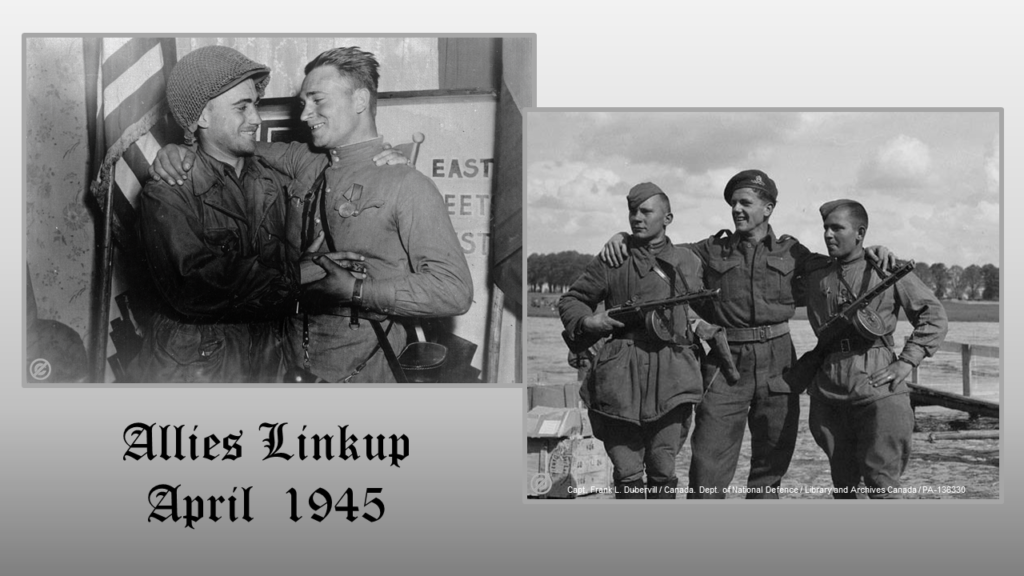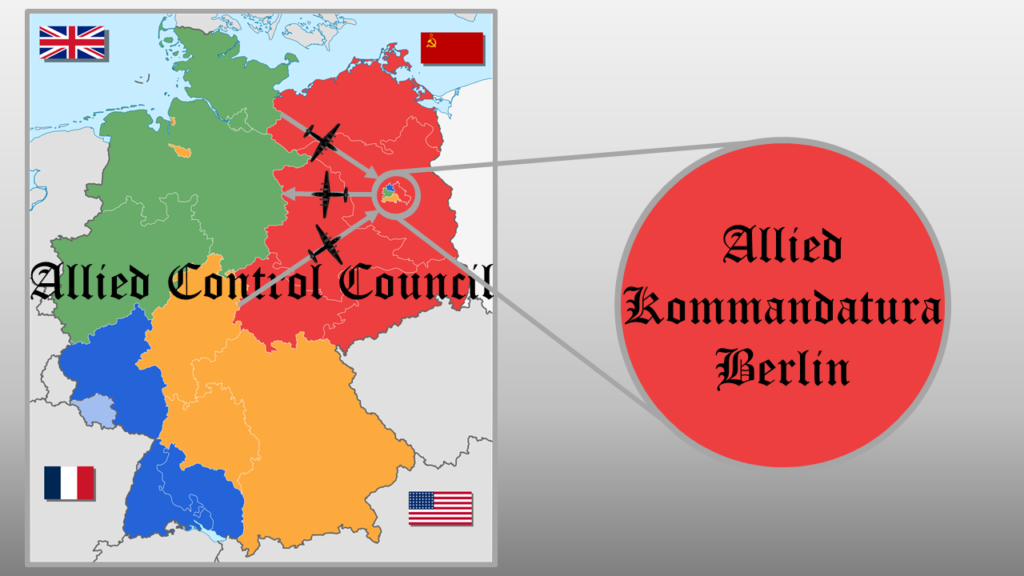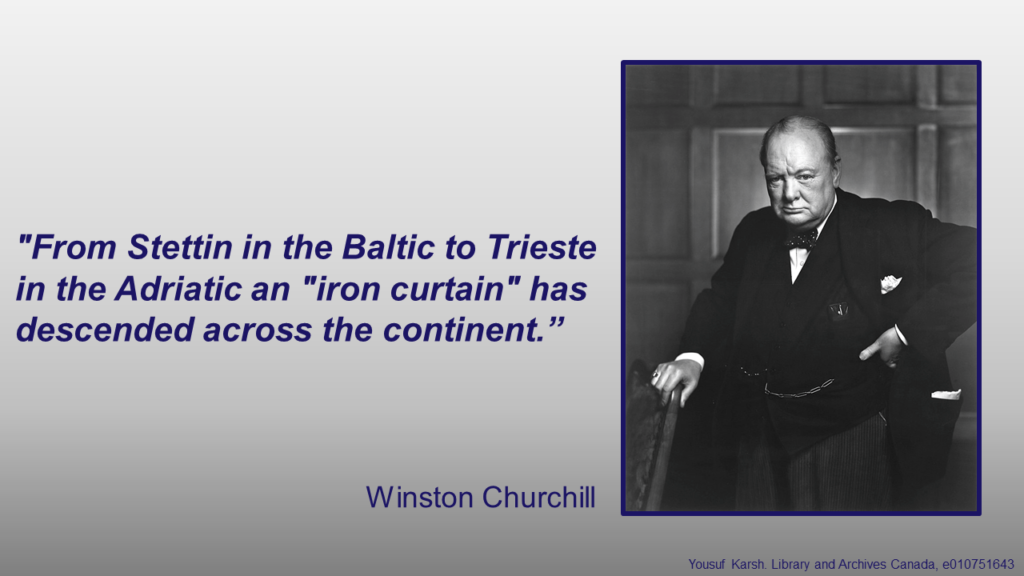
Introduction
The Berlin Airlift is one of my favorite historical projects, and this is the first of four posts on the topic.
The 25th of April 1945 was a day of celebration when American, British, Canadian, and Soviet* soldiers came together, on the banks of the river Elbe, in joy and friendship.
Who could have imagined that only three years later they would be on the brink of war?
How could such a change have taken place?

There was still some hard fighting before the war was finally over.
In Berlin, a ragtag of Wehrmacht¹, Waffen SS², and Volkssturm³ units prepared to face the final Soviet assault. Children as young as twelve went to the front in a futile attempt turn the Soviet tide. Heavily outnumbered and out gunned they fought street to street until finally the Soviets stormed the Reichstag building, taking it room by room.
On May 2nd, the war was effectively over, and the red flag flew over the Reichstag.

But it did not end there. The Soviet’s unleashed a violent reign of rape and pillage on the capital which continued for weeks. This as we shall see later would rebound on them in later years.
Whilst the fighting was still proceeding the allied leaders, (Roosevelt [USA], Churchill [UK], Stalin [Soviet Union] – often referred to as the “Big Three”- met in Yalta to determine how a post war Germany would be governed.
During these meetings Roosevelt, pivoted towards Stalin and left Churchill, feeling isolated. This was the start of a specific American policy of friendship and cooperation with the Soviet Union and a move away from the old imperial power.
Following Germany’s surrender, they met again at Potsdam in July, to thrash out the final details.
This time Harry Truman represented the US, replacing the Late President Roosevelt who had died in April.
It was agreed that Germany would be governed as a single unit, administered by an Allied Control Council, with the three powers having a seat and a veto. France was later added to the council.
Germany would be divided into four zones of occupation, and Berlin, the German capital although deep in the Soviet sector, would be similarly divided and governed.
Little thought was given to access rights to Berlin, but provision was made for three 20-mile-wide air corridors from the western zones of occupation to the western sectors of Berlin.

The Occupation Begins
The members of the Allied Control Council were:
- Gen. Lucius Clay (USA)
- Gen. Georgy Zhukov followed by General Vasily Sokolovsk (USSR)
- Gen. Brian Robertson (UK)
- Gen. Marie-Pierre Koenig (France)
The members of the Kommandatura Berlin were:
- Col. (Later Gen.) Frank Howley (USA)
- General Alexander Kotikov (USSR)
- General Geoffrey Bourne (UK)
- General Jean Ganeval (France)
Both bodies were military governorships.
As the occupation commenced the allies were determined not, as they saw it, to repeat the mistakes made after WWI. The intent of all the allies was to ensure that the Germans:
- Got the message that they had lost the war.
- That they would never again threaten their neighbors.
- That they would pay the allies reparations.
- That they would become a peaceful democratic country. (USSR as would be seen later did not really want the democratic part.)
American servicemen posted to occupied Germany were warned not to fraternize with the German civilians, because it was emphasized that they could not be trusted. One example should suffice to illustrate the attitude towards Germans:
On bases waste food was doused in petrol (gasoline) and burned to prevent German civilians scavenging.
This attitude would soften over time, but it was not until late 1947 that there were widespread efforts, by the western allies, to engage the Germans.
The occupation started with high hopes of friendship and cooperation between the allies.
An Iron Curtain Descends
Elections were duly held in 1946, and despite Soviet expectations the results favored non-communist parties. This was especially true in Berlin where the defeat was overwhelming. The actions of their troops in 1945 had come back to haunt them. The Soviets used their veto to prevent Ernst Reuter, a strong anti-communist, from assuming his role as mayor of Berlin. (More of him later) It was not long before there were signs that the Soviets had their own agenda and were just waiting for the US troops to go home.
Over the next year they subverted the governments in various countries and replaced them with communist regimes sympathetic to the USSR. This was done by various underhand methods, bribery, violence, and abuse of their power as the occupying authority.
Winston Churchill once again called out the aggressor, in his famous speech at Westminster College, Missouri, on 1st March 1946

But still the allies did nothing
In February 1948 the soviets engineered the overthrow of the democratic government in Czechoslovakia, and on 10th March the country’s President Jan Masaryk, was reported to have committed suicide, under extremely suspicious circumstances.
Finally, the alarm bells started to ring all over the west. The west was now in the same position that Britain and France had been in 1938, the appeasement had to stop. The western Europeans had signed a mutual protection pact, but without the US, which still had large isolationist factions, they were not hopeful of stemming any Soviet invasion
Turning the Screw
The Soviets now directed their efforts to Berlin, by harassing the city government, seizing opponents (who simply disappeared, even from the western sectors of the city).
The Allied Control Council, and the Kommandatura, ceased to be functioning bodies, and became a vehicle for Soviet propaganda and grandstanding.
General Clay warned Washington of the deterioration and that there was a possibility of war. There were discussions of evacuating western civilians, but Clay cautioned that this would politically play into the Soviet’s hands.
British Foreign Secretary Ernest Bevin although a member of a socialist government, was a vehement opponent of the USSR, and sought to rally the western powers, to oppose what was obviously an effort to drive them from Berlin.
By early 1948 the situation was deteriorating and the three western occupying powers and the three Benelux countries (Belgium, Netherlands, and Luxemburg), held a conference in London to discuss the future of Germany and ultimately Europe.
The outcome of the conference was that the three western occupation zones would be combined to form a democratic federal republic.
The Reichsmark which was currently in use in all parts of Germany was so devalued, that American cigarettes were a more stable method of exchange. (This desperate situation was not helped by poor currency management on the part of the Soviets.)
It was therefore decided to issue a new currency, the “Deutsche Mark”, in all western sectors
At the Allied Control Council meeting on the 20th March General Sokolovsk, asked the other representatives for details of the outcome of the conference. They indicated that they would need clearance from their governments to discuss the matter.
Sokolovsk used this as a pretext to walk out of the meeting, effectively dissolving the council.
The Soviets now increased the level of intimidation applied to the Berlin government. Western leaning members were harassed and beaten. They also instigated a propaganda campaign to drive a wedge between the Berliners and the western allies.
Transport between the west and Berlin was increasingly disrupted, and at times halted for several days. With trains being forced to return to the west.
There was now talk within the western governments and military about withdrawing from Berlin. However General Clay insisted that any withdrawal would play into the Soviet’s hands.
Things continued to stumble along, but it was apparent something had to give.
On the 16th of June the Soviets engineered a walkout from the Kommandatura, closing the last official East/West governing body.
The western allies introduced the Deutsche Mark, on the 21st June.
Shortly afterwards on the 24th June the Soviets announced the closure of all land and water links between the west and Berlin.
The Berlin Blockade had begun.
How would the western allies respond?
Conclusion
What lessons can we learn as project managers from the western handling of the prelude to the Blockade?
The western allies were not clear on what they wanted to achieve, apart from making the Germans pay.
Despite the recent lesson of Hitler, they let the Soviets (who did have a clear idea what they wanted) annex country after country and use brutal tactics in Berlin. Like Hitler they would continue if it were working.
The U.S., which was realistically the only western power who could stand up to the Soviets, for too long continued the policy of friendship with the Soviets, in the belief working together would become easier.
What could have helped:
- Better business analysis and a clear business plan.
- A clear scope.
- A good understanding of the stakeholders.
- Specifically identify the hostile stakeholders and manage accordingly.
NOTES
Wehrmacht¹ The German Army.
Waffen SS² The military branch of the SS.
Volkssturm³ The “Home Guard”, or Militia.
Note: I am using the terms Soviet, Soviet Union, and USSR interchangeably, to indicate the union of communist states governed from Moscow, from 1922 to 1991.

Your best blog article yet!
Berlin Airlift: truly an epic project and a great case study. Lots and lots of lessons for us project managers to learn.
Looking forward to the rest of the series.
I really enjoyed how easy it is to read and how you correlated history to project management principles.